Mutual Fund Liquid Funds : good option to park your surplus cash Part 1

Where do we park our surplus cash? Most of us keep it in our savings bank account. If we need to use the cash on a regular basis, savings bank indeed is the best option. It is safe and it is convenient. We can withdraw cash from our savings bank account at any time, using our ATM or debit card. However, investors should, from time to time, take a look at their savings bank account statement and ask themselves, how much balance they should have in their savings bank account? Financial planners suggest that, we should have six months of emergency funds. But we sometimes have much more than that in our savings bank account. Investors often keep funds parked in their savings bank while waiting for suitable investment opportunities or an upcoming expense. If you do not intend to use your funds for a more than year, investing it in fixed deposits or fixed maturity plans (FMPs) is a better option. Fixed deposits or FMPs give a pre-tax return of 9 - 10%, whereas the savings bank interest rate is usually only 4% and that too fully taxable. However if you do not want to lock your funds for a year, then liquid funds or ultra short-term debt funds are better options than savings bank in terms of return on your investment. Liquid funds and ultra short term debt funds can give pre-tax returns of 9 – 10%, compared to the 4% interest paid by savings bank. In this article we will discuss about liquid funds.
Liquid fund are money market mutual funds and invest primarily in money market instruments like treasury bills, certificate of deposits and commercial papers and term deposits, with the objective of providing investors an opportunity to earn returns, without compromising on the liquidity of the investment. Typically they invest in money market securities that have a residual maturity of less than or equal to 91 days. This helps the fund managers of liquid funds in meeting the redemption demand from the investors.
Key Benefits of Liquid Funds
High liquidity:
Most liquid funds do not have any exit load. Even those funds that have exit load charge a nominal load for funds redeemed within a week or a month. Withdrawals from liquid funds are processed within 24 hours on business days. Some liquid funds offer cash withdrawal facilities with ATM cards, but most do not.Higher returns than savings bank:
Liquid funds give higher returns than savings bank. Savings bank interest rate is around 4% (some banks offer slightly higher rates, subject to a minimum balance), calculated on daily balance and compounded monthly. Top ranked liquid funds have given 9 – 10% pre tax returns.Low volatility:
Liquid funds are less volatile than longer term debt funds, since the underlying securities in their investment portfolio have short durations. Fixed income securities with short durations or maturities have lower interest rate risk, since the probability of the interest rates changing before the maturity of the securities is lower.Tax efficiency:
If liquid funds are redeemed within a year, then capital gains are taxed at the applicable income tax slab rate of the investor. In that respect, the tax treatment for both savings bank and liquid funds redeemed within one year are the same. Dividends from liquid funds are tax free in the hands of the investors, but the fund houses have to pay a dividend distribution tax of 28.325% before distributing dividends to the investors. We will discuss later in the article, how investors in the highest tax bracket, can reduce their effective tax rate by opting for the dividend re-investment option. If liquid funds are held for over a year, then tax rate on capital gains will be 10% without indexation and 20% with indexation.
Performance of top ranked liquid funds
The chart below shows the last 1 year returns of some of the top ranked (based on CRISIL rankings) liquid funds. As you can see on the chart, returns from liquid funds are more than double of the interest from your savings bank account.
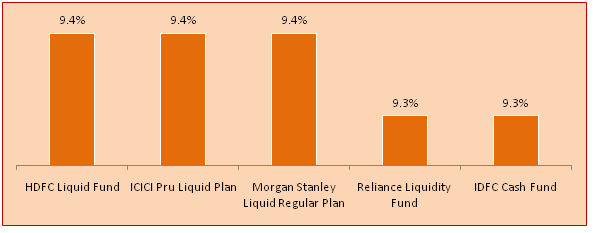
Not just in terms of 1 year returns, liquid funds have given more returns than savings bank even in the 1 month, 3 months and 6 months time frames. See the chart below.
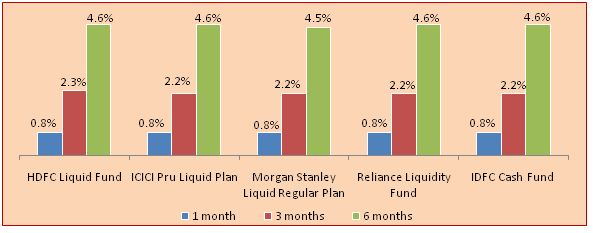
The chart below shows the pre tax returns of Rs 5 lakhs investment in a liquid fund (e.g. HDFC Liquid Fund) and savings bank (with average daily balance of Rs 5 lakhs) over 1 month, 3 months, 6 months and 1 year.
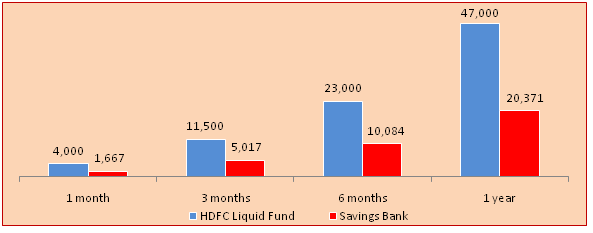
The chart above clearly shows that if you do not need all the money in your savings bank account on an immediate basis, you are better off investing it in a liquid fund. At any point of time, if you need the funds you can put in a redemption request. If you put in the redemption request before 3 pm, the funds will be transferred to your bank account before 10am on the next business day.
Choosing a liquid fund
The returns from liquid funds don't vary much as they invest in same universe of money market securities (see the chart above showing returns from different liquid funds). However, investors should select liquid funds from reputed AMCs and funds that have substantial assets under management (AUM). Liquid funds come with different distribution options e.g. growth plan, daily dividend plan, monthly plan. You should consider your tax situation, when you decide which plan to invest in. As discussed earlier, short term capital gains from liquid funds are taxed at the applicable income tax slab rate of the investor. Dividends from liquid funds are tax free in the hands of the investors, but the fund houses have to pay a dividend distribution tax (DDT) of 28.325% before distributing dividends to the investors. If you fall in the 10% or 20% tax bracket, you should invest in the growth plan, since your tax rate is lower than the dividend distribution tax rate. On the other hand, if you are in the highest tax bracket (30%), then dividend re-investment will be smarter option from a tax perspective. Let us illustrate with an example.
Let us assume you are an investor in the highest tax bracket. You have invested Rs 1 lakh of your surplus cash in ICICI Prudential Liquid fund on Sep 1, 2013. You redeemed your units on Mar 31, 2014. You had two options in which to invest your funds.
- Growth Plan
- Monthly Dividend Plan, with Dividend Reinvestment
Let us examine your returns in each of these options.
Option 1: Growth Plan
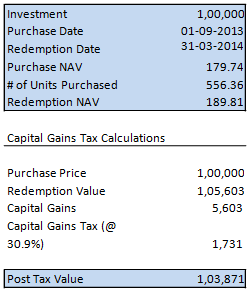
The post tax value of your investment on redemption is Rs 1,03,871. Let us examine your returns, if you had chosen the monthly dividend plan, with dividend re-investment.
Option 2: monthly dividend plan with dividend re-investment
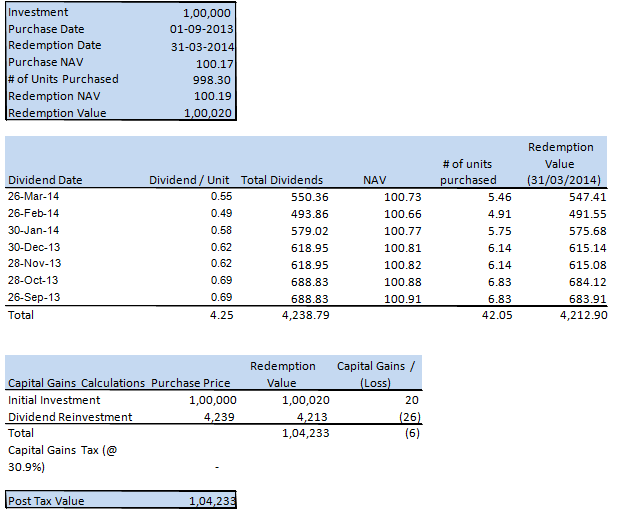
The post tax value of your investment on redemption is Rs 1,04,233. Clearly, you are better off with dividend re-investment option. This is because, in the growth option you had pay capital gains tax at the rate of 30.9%, whereas in the dividend re-investment option the fund house paid divided distribution tax at the 28.35% and distributed dividends, which was the tax free in your hands. The dividends were stripped from the NAV and at the end you did not have to pay any capital gains tax. Though the difference in returns between the two options in the above example is quite small, it would be significant if the size of your investment is bigger.
Conclusion
Liquid funds are very popular among large corporations for parking their surplus funds. However, retail participation in liquid funds is still very low. Convenience of keeping money in savings bank account and lack of awareness about liquid funds prevent retail investors from earning higher returns. However, if you are ready to put in a little bit of effort, you will find that investing your surplus cash in liquid funds is a much smarter option than having it lie idle in your savings bank account. You should consult with your financial adviser if liquid funds are suitable for parking your surplus funds for a short term. In the next article in this series, we will discuss about another short term option of parking your surplus funds, ultra short term debt fund.
Queries
-
What is the benefit of mutual fund STP
Aug 29, 2019
-
How much to invest to meet target amount of Rs 2 Crores
Aug 26, 2019
-
Can I achieve my financial goals with my current mutual fund investments
Aug 24, 2019
-
Can you tell me return of various indices
Aug 19, 2019
-
What would be the post tax return on different investments
Aug 18, 2019
-
Which Principal Mutual Fund scheme will be suitable for my retirement corpus
Aug 16, 2019
-
What is the minimum holding period for availing NCD interest
Aug 4, 2019
Top Performing Mutual Funds
Recommended Reading
Fund News
-
DSP Mutual Fund launches DSP Nifty Next 50 ETF
Dec 19, 2025 by Advisorkhoj Team
-
DSP Mutual Fund launches DSP Nifty 500 Index Fund
Dec 19, 2025 by Advisorkhoj Team
-
Kotak Mahindra Mutual Fund launches Kotak Nifty Next 50 ETF
Dec 18, 2025 by Advisorkhoj Team
-
The Wealth Company Mutual Fund launches The Wealth Company Gold ETF
Dec 16, 2025 by Advisorkhoj Team
-
Axis Mutual Fund launches Axis Gold and Silver Passive FOF
Dec 10, 2025 by Advisorkhoj Team














